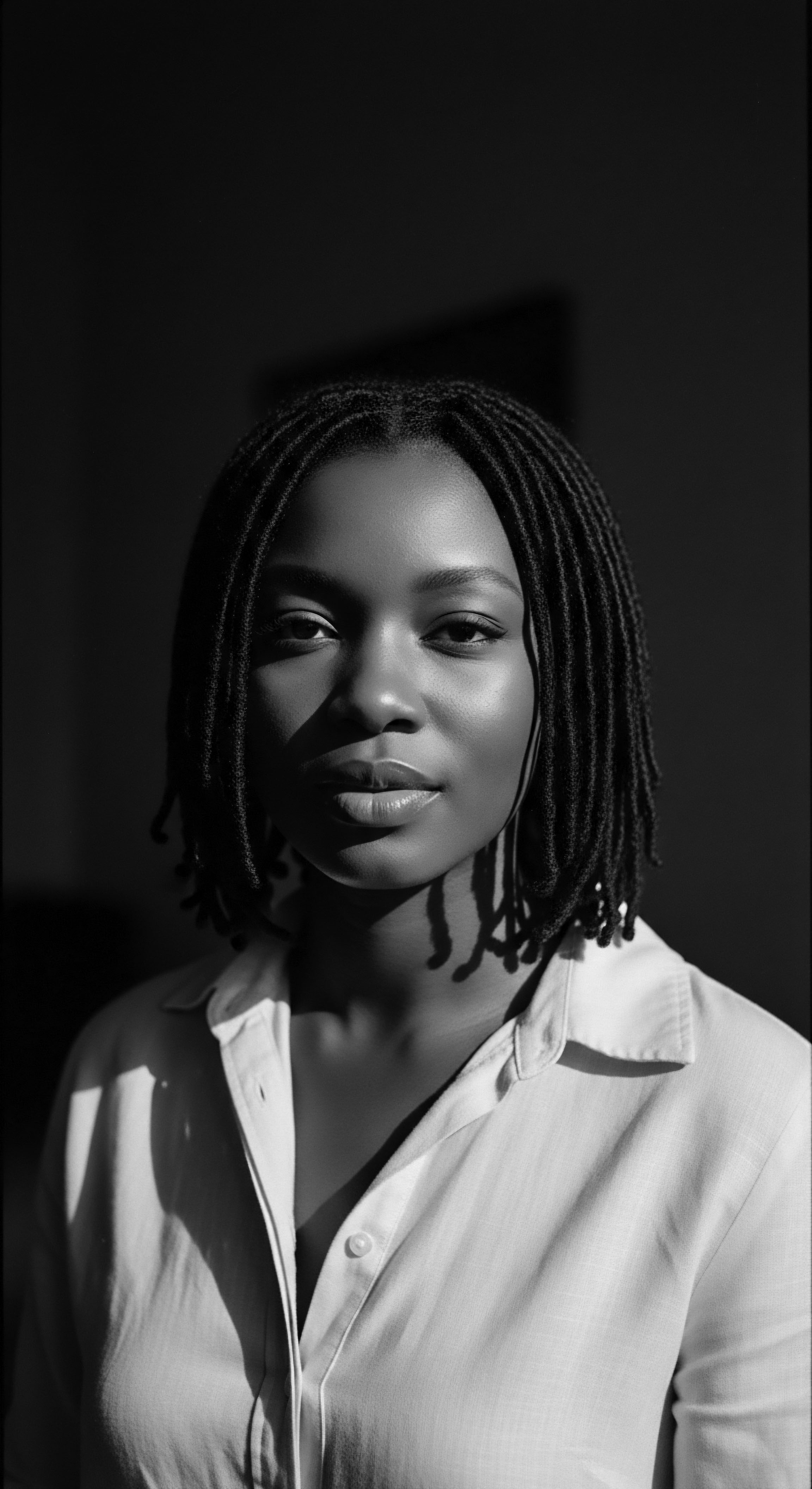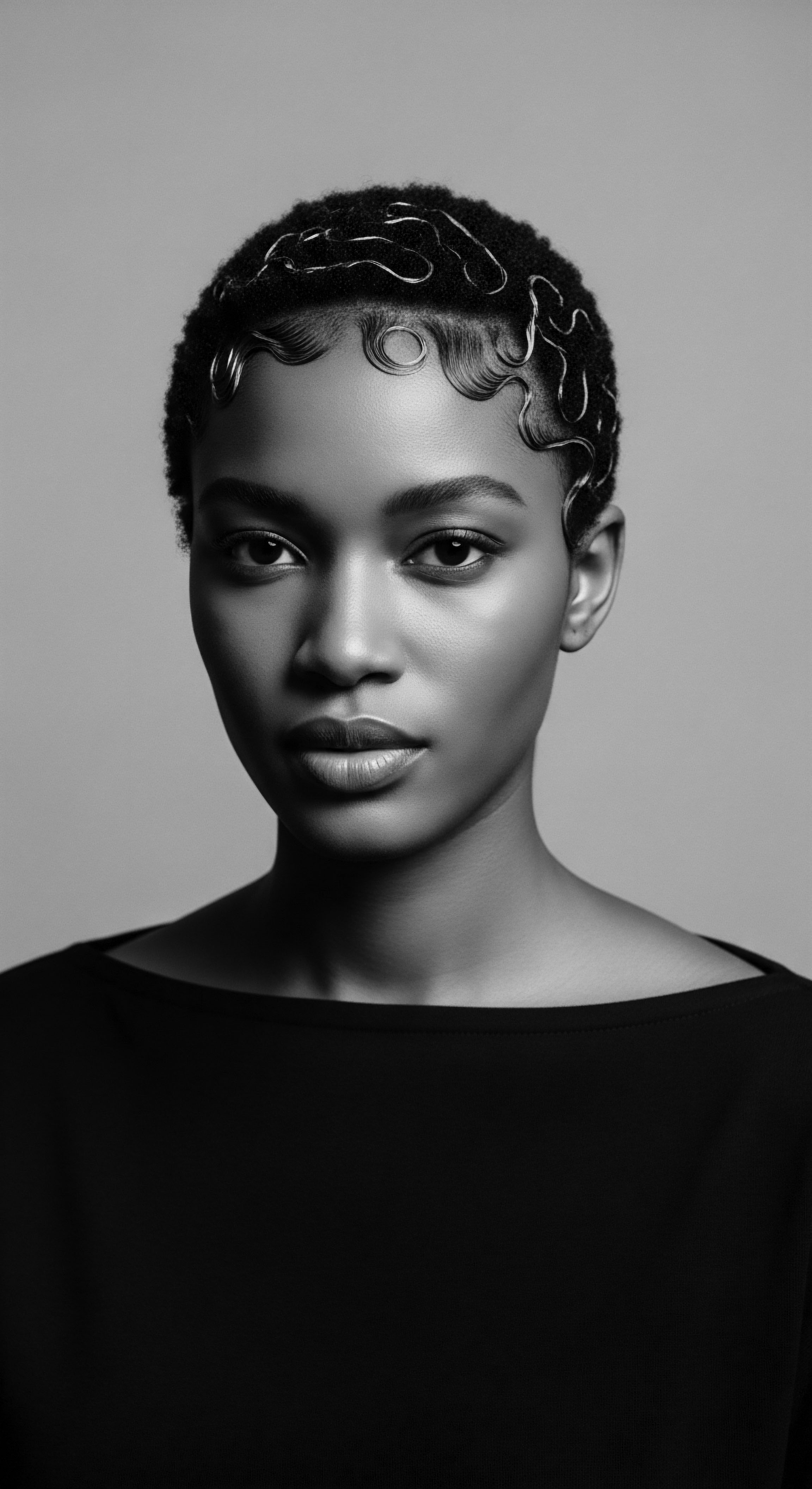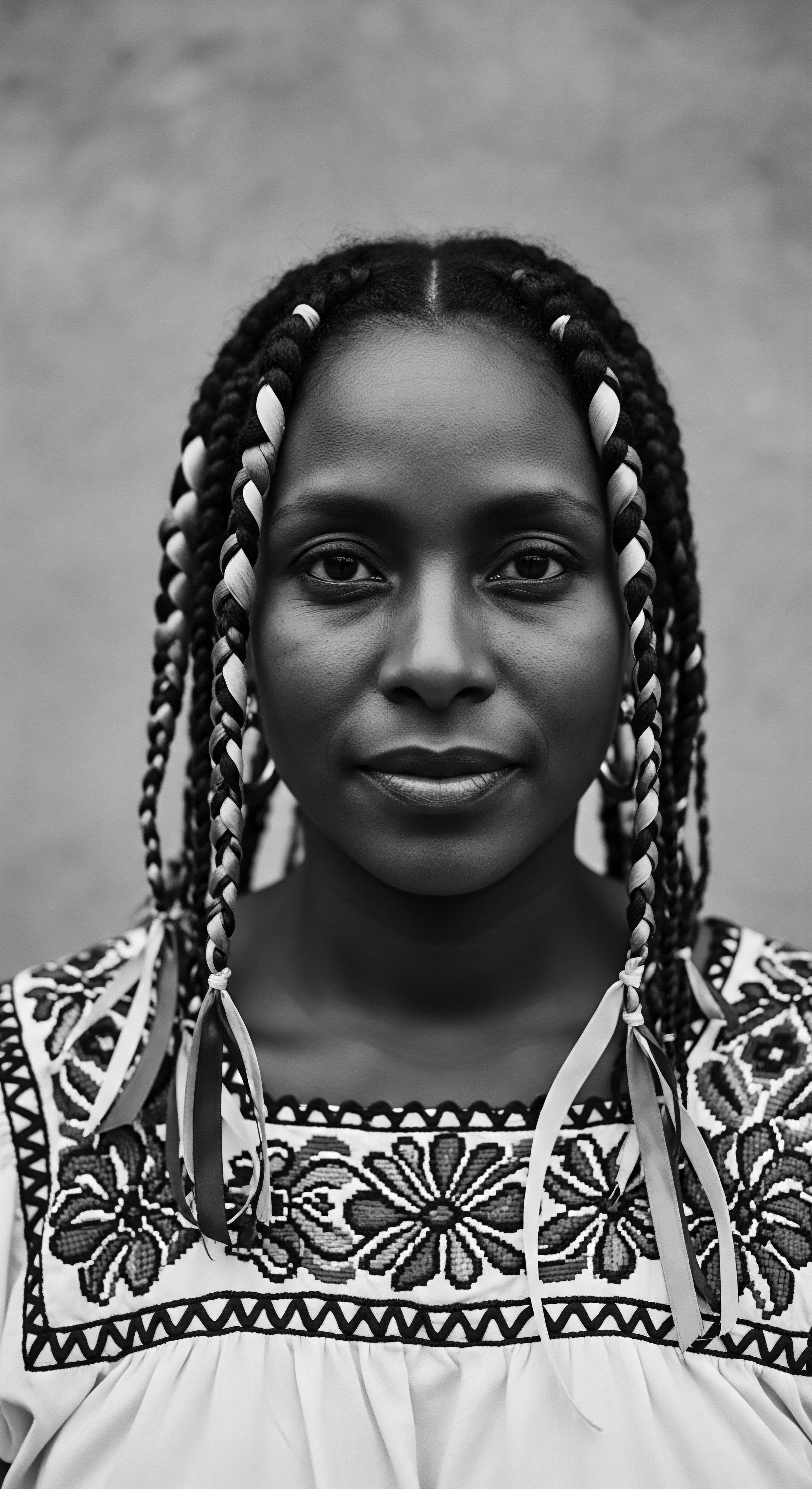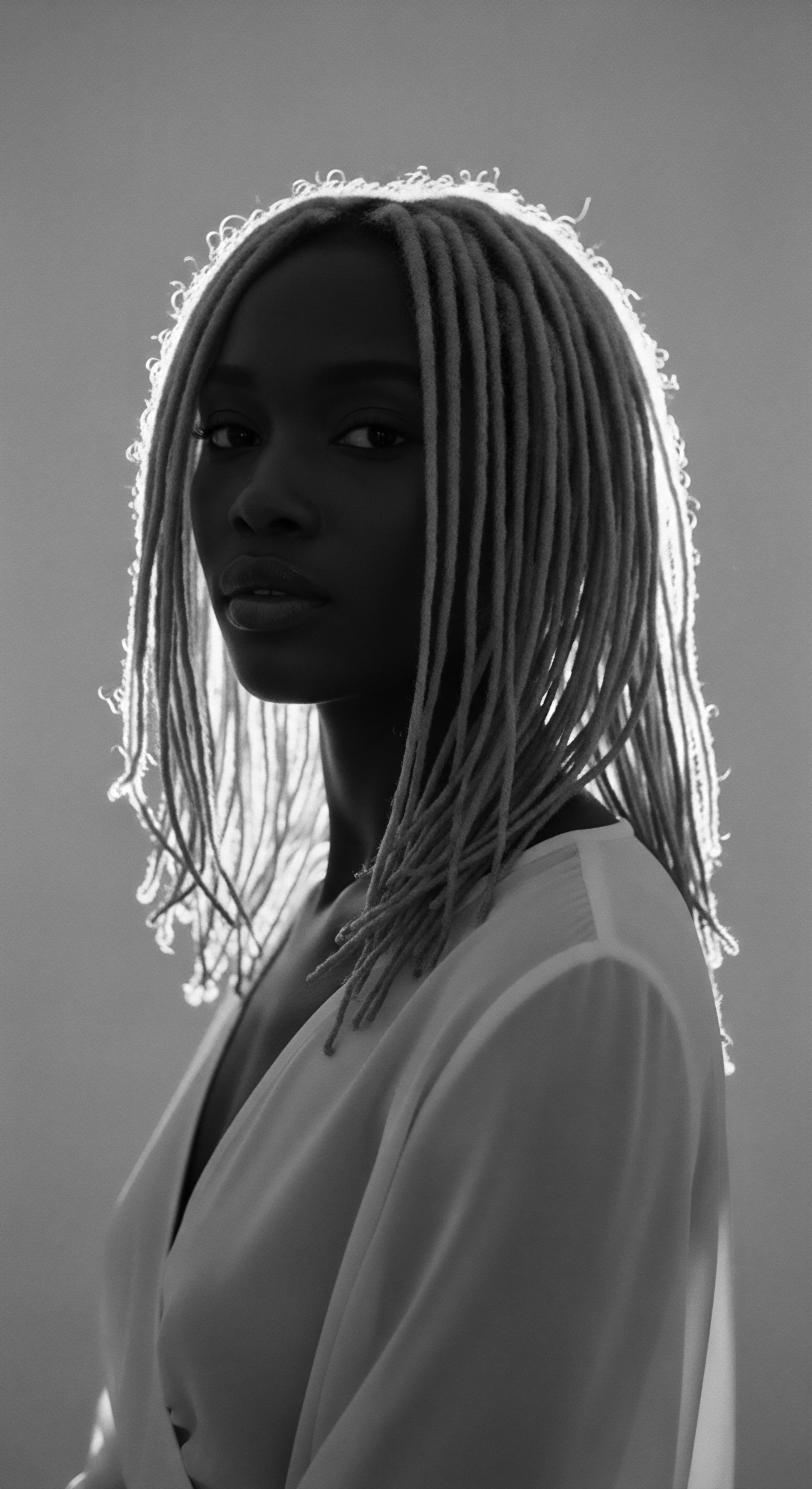
Roots
Consider the singular strand, a delicate helix spun from ancestral memory, yet tethered firmly to the present. Each coil, each curve, whispers stories of resilience, ingenuity, and a profound connection to the earth’s elemental rhythms. For those whose lineage traces back through the rich, varied landscapes of Africa and its diaspora, hair is never simply a biological outgrowth. It forms a living archive, a scroll upon which generations have inscribed their journey.
Within this deeply personal yet profoundly communal text, the headwrap holds a cherished place. It arrived not as a mere adornment but as a silent sentinel, guarding, signifying, and transforming the very understanding of textured hair heritage.
To truly grasp the headwrap’s historical weight, we must first honor the hair it protects. Our textured strands, with their unique elliptical cross-sections and complex curl patterns, possess an ancient lineage. From the earliest human communities on the African continent, these hair structures were not only celebrated for their beauty but understood for their inherent vulnerability to harsh climates. The sun’s unrelenting glare, the pervasive dust of dry seasons, the nightly chill – all posed challenges to the delicate protein bonds of natural coils.
Before manufactured conditioners and chemical treatments, ancestral ingenuity provided solutions, and among the earliest, simplest, and most effective was the practice of wrapping. These early coverings were not about hiding; they were about Preserving, about shielding a sacred part of the self from environmental aggressors, ensuring vitality for both personal well-being and community vibrancy.

Ancient Adornments and Ancestral Threads
Long before the transatlantic crossings, head coverings held multifaceted meaning across diverse African societies. They were markers of status, marital standing, and ritualistic observance. Imagine the intricate artistry of a woman in ancient Egypt, her carefully braided and adorned hair shielded by fine linen, or the vibrant textiles gracing the heads of royalty in West African kingdoms, each fold and knot conveying a silent language of power and identity.
These were not random acts of covering; they were deliberate choices rooted in deep cultural understanding. The materials themselves—cotton, linen, bark cloth—were often grown or crafted within the community, connecting the adornment directly to the land and its resources.
Early head coverings served as a testament to humanity’s earliest relationship with hair health. They minimized breakage from friction during daily tasks, protected the scalp from drying winds, and helped retain natural moisture. For textured hair, which tends to be drier than straight strands due to its structure, this protective function was especially vital.
The wrap became an extension of the hair itself, a soft cocoon against external forces, allowing the hair to maintain its inherent strength and pliability. This fundamental care practice forms a bedrock of our textured hair legacy.

Decoding Textured Hair’s Ancestry
Understanding the biological framework of textured hair helps explain the intrinsic utility of headwraps. Each strand springs from a follicle that is often curved, causing the hair to grow in a spiraling pattern. This very architecture, while granting unparalleled volume and styling versatility, also presents points of vulnerability.
The curves create areas where the cuticle, the hair’s protective outer layer, lifts slightly, making it more susceptible to environmental damage and tangling. Furthermore, the natural oils produced by the scalp, known as sebum, travel down a coiled strand less efficiently than down a straight one, contributing to natural dryness.
Ancestral communities instinctively understood these characteristics, even without scientific terminology. Their practices, including the use of head coverings, were often direct responses to these inherent qualities. The wrap acted as a barrier, preventing dust and debris from settling on the scalp and hair, which could clog follicles or dull the hair’s natural sheen.
It also served as a means to hold in applied emollients—plant oils, butters, and infusions derived from local flora—allowing them to deeply condition the strands without quick evaporation. This tradition of care, passed down through generations, shaped the very resilience of textured hair.

Why Did Our Ancestors Cloak Their Crowns?
The decision to cover the head, particularly the hair, held layers of meaning stretching back through millennia. It was a multifaceted practice, encompassing spiritual reverence, practical protection, and social communication. Across various African civilizations, the head and hair were often considered the seat of one’s spirit, wisdom, and connection to the divine. To cover it could be an act of reverence, humility, or spiritual readiness.
The headwrap initially served as a practical shield for delicate textured hair against environmental elements, simultaneously marking social and spiritual significance across ancient African societies.
Beyond the sacred, wraps were intensely practical. Agricultural work, daily chores, and travel exposed hair to the elements, making tangling, breakage, and dryness common occurrences. A well-placed cloth provided immediate respite and sustained defense. Consider the materials used ❉ often natural fibers like cotton, which allowed for breathability while absorbing excess moisture from sweat or maintaining hydration from hair products.
The patterns and dyes also served as visual identifiers for tribes, families, or specific life stages, forming an early, unspoken language etched in fabric. These roles, deeply ingrained in cultural practice, formed the bedrock upon which the headwrap’s enduring legacy would be built, even as circumstances radically shifted.

Ritual
The passage of time, marked by profound societal upheaval, shifted the headwrap’s purpose, yet deepened its symbolic weight. What began as a garment of practical utility and cultural expression in Africa transformed into a complex symbol of survival, resistance, and identity during the transatlantic slave trade and its aftermath. As enslaved Africans were forcibly brought to new lands, their traditional ways, including hair practices, faced brutal assault.
Hair, once a source of pride and elaborate artistry, became a site of degradation and control. Yet, from this crucible of oppression, the headwrap emerged not just intact, but fortified, taking on new and layered meanings as a powerful component of textured hair heritage.
The forced removal of identity, the stripping of cultural markers, meant that even the simplest acts of adornment became revolutionary. Hair, often neglected or forcibly shorn during enslavement, could still be adorned or protected with improvised cloths. These head coverings, fashioned from scraps of fabric or utilitarian materials, became a quiet defiance, a way to reclaim agency over one’s body and appearance when so much else was denied. They shielded hair from the harsh conditions of labor, prevented tangling, and offered a semblance of personal grooming, allowing individuals to hold onto fragments of selfhood and dignity in inhumane circumstances.

The Language of Fabric and Form
As the African diaspora spread across the Americas, headwrap styles diversified and assimilated new influences, while holding onto foundational African principles. In the Caribbean, the headtie became a vibrant expression, often influenced by local flora and fauna, or the specific materials available through trade. In the southern United States, utilitarian functions mingled with unspoken codes.
The manner of tying, the patterns chosen, even the quality of the fabric, could communicate messages understood only within the Black community—messages of mourning, celebration, protest, or even readiness for revolt. This internal dialogue, expressed through the very fabric of identity, allowed for solidarity and communication in systems designed to isolate.
This evolution underscores how the headwrap became a visual dialect within the Black experience, a silent language of aesthetic resilience. Despite efforts to strip away cultural identity, the continuity of head covering practices persisted, adapted, and flourished, demonstrating an incredible capacity for cultural preservation and innovation against formidable odds.

Styling as Resistance and Reclamation
Perhaps one of the most powerful historical illustrations of the headwrap’s role in both suppression and self-expression comes from the infamous Tignon Laws of Louisiana. Enacted in 1786 by Governor Esteban Miro, these laws mandated that free women of color in New Orleans wear a tignon—a kerchief or head covering—over their hair when in public. The stated intent was to mark their perceived lower status, distinguishing them from white women and suppressing what was considered their excessive adornment and attraction. Yet, these women, with ancestral ingenuity deeply ingrained, transformed the very instrument of oppression into a symbol of defiance and beauty.
(Byrd and Tharps, 2001, p. 55)
Instead of simple, drab coverings, they adorned their tignons with exquisite fabrics, vibrant colors, jewels, and intricate ties, turning them into elaborate statements of fashion and pride. The very act of covering became an act of artistic expression, attracting even more attention and admiration, thereby subverting the law’s original intent. This historical moment is a profound testament to the resilience of Black women, their capacity to reclaim personal agency, and the headwrap’s enduring power as a symbol of cultural fortitude and self-worth.
Beyond direct acts of legal resistance, the headwrap also served a continuous, daily purpose of Protective Styling. For those working long hours in fields or homes, the wrap offered essential protection for intricate braids, twists, or cornrows that took hours to create and were meant to last for extended periods. It kept hair clean, minimized sun exposure, and helped preserve moisture, which was crucial for maintaining hair health in conditions where proper care products were scarce or nonexistent. This dual function—symbolic and practical—cemented the headwrap’s central position in Black hair heritage.
The headwrap’s transformation from a symbol of status to one of resistance during slavery highlights its adaptable yet enduring connection to Black identity and hair protection.
| Era Pre-Colonial Africa |
| Primary Cultural Meaning Status, spirituality, community affiliation, marital status. |
| Hair Protection Aspect Shield from elements (sun, dust), moisture retention for coiled strands. |
| Era Slavery & Post-Emancipation |
| Primary Cultural Meaning Forced demarcation, quiet resistance, reclaiming dignity, subtle communication. |
| Hair Protection Aspect Concealment of neglected hair, protection during labor, preservation of styles. |
| Era Civil Rights Era |
| Primary Cultural Meaning Symbol of Black pride, cultural affirmation, political statement. |
| Hair Protection Aspect Practicality for daily life, maintenance of natural styles. |
| Era The headwrap's meaning evolved, yet its practical role in safeguarding textured hair remained a constant thread through history. |

Did Headwraps Shield More Than Just Strands?
The layers of fabric, meticulously tied or casually draped, protected more than just fragile strands. They shielded dignity, preserved cultural memory, and offered a semblance of personal space in environments that sought to strip it away. In an era where Black bodies and traditions were under constant assault, the headwrap provided a quiet, visual refuge. It allowed individuals to carry a piece of their homeland, a whisper of ancestral artistry, on their very heads.
Consider the psychological comfort it offered ❉ a sense of composure, a barrier against intrusive gazes, and a private sanctuary for thoughts and feelings. This emotional protection is as much a part of the headwrap’s history as its physical benefits. It became a personal fortress, a silent testament to an inner world that remained unbound, even when the external world sought to impose strictures. This resilience, deeply interwoven with the fabric itself, is a testament to the enduring spirit it represents.

Relay
The legacy of the headwrap, tempered by centuries of adaptation and symbolism, flows seamlessly into the present. It stands today as a vibrant symbol, a tangible connection to the past, and a contemporary tool for self-care and expression within textured hair heritage. Its journey from an ancestral shield to a emblem of resistance, and now to a celebrated fashion statement and wellness staple, reflects the ongoing vitality of Black hair culture. The headwrap’s continued presence is a powerful relay of history, echoing ancestral wisdom through modern practices.
Contemporary uses of the headwrap are as diverse as the textures it protects. From high fashion runways to everyday street style, from protest rallies to sacred ceremonies, the headwrap is a visible assertion of identity. It speaks to a reclamation of beauty standards, a rejection of Eurocentric norms, and a profound respect for the roots that ground one’s existence. This modern resurgence is not merely a trend; it represents a conscious choice to honor a deep cultural lineage, recognizing the protective and symbolic power inherent in the fabric itself.

Modern Echoes of Ancestral Practice
In the contemporary landscape of textured hair care, the headwrap, in its various forms, maintains its original protective functions. The silk or satin bonnet, a ubiquitous nighttime accessory for many with textured hair, is a direct descendant of the historical head covering. These smooth fabrics reduce friction against pillowcases, preventing breakage, preserving intricate styles, and locking in moisture. This modern iteration validates the ancient wisdom that understanding hair’s vulnerability, especially during rest, is central to its health.
The deliberate choice of materials—silk and satin—highlights a scientific understanding that aligns with ancestral knowledge. Unlike cotton, which can absorb moisture from hair, silk and satin allow hair’s natural oils and applied products to remain on the strands, promoting hydration and minimizing frizz. This continuity of purpose, though expressed with different materials, shows a clear lineage from ancient practices to contemporary wellness routines for textured hair.
- Silk Scarves ❉ Often used for nighttime protection or during styling processes to keep hair smooth and moisturized.
- Satin Bonnets ❉ A common bedtime accessory designed to reduce friction and maintain delicate curl patterns.
- Ankara Wraps ❉ Vibrant, patterned cloths used for fashion, cultural expression, and daily hair protection.
- Turbans ❉ Styled for both fashion statements and to conceal hair during transition or growth phases.

Science, Sanctuary, and the Crown’s Legacy
Modern trichology and hair science now readily affirm many of the benefits that ancestral communities understood intuitively. The delicate structure of textured hair, characterized by its numerous bends and twists, means that each curve is a potential point of weakness. Friction, whether from clothing, pillowcases, or environmental exposure, can cause the cuticle to lift and eventually break, leading to dryness and frizz. Headwraps, particularly those made from smooth, low-friction materials, mitigate this risk directly.
The modern embrace of headwraps, bonnets, and wraps reflects a continuous ancestral wisdom regarding textured hair’s need for gentle protection and mindful care.
Beyond physical protection, the headwrap continues to offer a psychological sanctuary. In a world where Black women’s hair is often policed or misunderstood, the headwrap grants agency. It allows for a moment of pause, a deliberate choice to cloak one’s crown, whether for convenience, spiritual alignment, or simply to assert cultural pride. It becomes a personal act of self-definition, a quiet rebellion against external pressures, and a celebration of one’s inherent beauty.
This enduring legacy reminds us that hair is more than just protein; it is memory, history, and a future unbound. The headwrap, therefore, is not a static artifact of the past but a living, breathing component of textured hair heritage, continually evolving yet eternally connected to its deep roots. It speaks to the enduring ingenuity of a people who have consistently transformed challenges into opportunities for creative expression and profound cultural affirmation.

How Do Headwraps Speak to Our Textured Heritage Today?
Today’s headwrap speaks volumes about continuity and reclamation. It serves as a bridge, connecting individuals to the wisdom of their forebears while simultaneously expressing contemporary identity. The act of tying a headwrap can be a daily ritual of mindfulness, a moment to acknowledge the ancestral hands that perfected similar gestures centuries ago. It represents a conscious choice to honor a lineage of resilience, beauty, and ingenious care.
Moreover, headwraps are central to broader conversations about cultural appropriation and appreciation. Their rich history demands respect and understanding, serving as a reminder that beauty practices are often deeply embedded in specific cultural narratives. To wear a headwrap today is to participate in this ongoing dialogue, to acknowledge the weight of its journey, and to contribute to its vibrant future. It is a declaration that the heritage of textured hair, in all its forms and expressions, continues to thrive and influence global aesthetics, forever rooted in its own authentic story.
| Benefit Area Protection from Elements |
| Traditional Context (e.g. Historical African/Diaspora) Shielded from sun, dust, and environmental debris during daily tasks and travel. |
| Modern Context (e.g. Current Textured Hair Care) Protects from environmental pollutants, prevents sun damage, and reduces wind exposure. |
| Benefit Area Moisture Retention |
| Traditional Context (e.g. Historical African/Diaspora) Helped keep natural oils and applied plant-based emollients from evaporating quickly. |
| Modern Context (e.g. Current Textured Hair Care) Minimizes moisture loss, especially overnight, using smooth fabrics like silk/satin. |
| Benefit Area Friction Reduction |
| Traditional Context (e.g. Historical African/Diaspora) Reduced tangling and breakage from physical activity and rough surfaces. |
| Modern Context (e.g. Current Textured Hair Care) Prevents mechanical damage (snags, splits) caused by abrasive fabrics or movement. |
| Benefit Area Style Preservation |
| Traditional Context (e.g. Historical African/Diaspora) Maintained intricate braided or twisted styles for extended periods between re-dos. |
| Modern Context (e.g. Current Textured Hair Care) Keeps curl patterns defined, reduces frizz, and extends the life of various styles. |
| Benefit Area Cultural/Symbolic Value |
| Traditional Context (e.g. Historical African/Diaspora) Communicated status, identity, spiritual connection, and resistance. |
| Modern Context (e.g. Current Textured Hair Care) Asserts cultural pride, fashion statement, personal expression, and self-care. |
| Benefit Area The enduring benefits of head coverings for textured hair continue, adapting materials and styles while preserving core protective and symbolic values. |

Reflection
The headwrap, in its profound simplicity and boundless adaptability, stands as a testament to the enduring spirit of textured hair heritage. It is more than fabric; it represents a living thread in the intricate weaving of Black and mixed-race experiences. From its elemental origins as a protective covering on ancestral lands to its powerful transformation into a symbol of defiance and beauty against the harshest oppressions, and now to its renewed prominence as a wellness tool and fashion statement, the headwrap speaks to an unbroken lineage.
It reminds us that care for our crowns is not a recent innovation but a practice rooted deeply in historical ingenuity and cultural preservation. The soul of a strand, indeed, finds its voice, its sanctuary, and its boundless expression within the folds of this timeless adornment, continually reaffirming a profound connection to the past and an expansive vision for the future of textured hair.

References
- Byrd, Ayana, and Lori L. Tharps. Hair Story ❉ Untangling the Roots of Black Hair in America. St. Martin’s Press, 2001.
- Hall, Gwendolyn Midlo. Africans in Colonial Louisiana ❉ The Eighteenth-Century Slave Database. Louisiana State University Press, 1992.
- Sieber, Roy, and Frank Herreman, editors. Hair in African Art and Culture. The Museum for African Art, 2000.
- White, Shane, and Graham White. Stylin’ ❉ African American Expressive Culture from Its Beginnings to the Zoot Suit. Cornell University Press, 1998.
- Banks, Ingrid. Hair Matters ❉ Beauty, Power, and the Politics of Dreadlocks. New York University Press, 2000.
- hooks, bell. Ain’t I a Woman ❉ Black Women and Feminism. South End Press, 1981.
- Washington, Harriet A. Medical Apartheid ❉ The Dark History of Medical Experimentation on Black Americans from Colonial Times to the Present. Doubleday, 2007.
- Gilroy, Paul. The Black Atlantic ❉ Modernity and Double Consciousness. Harvard University Press, 1993.
